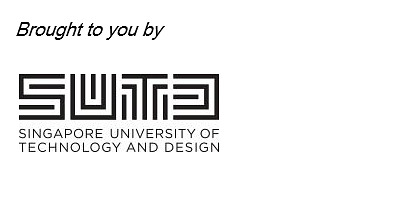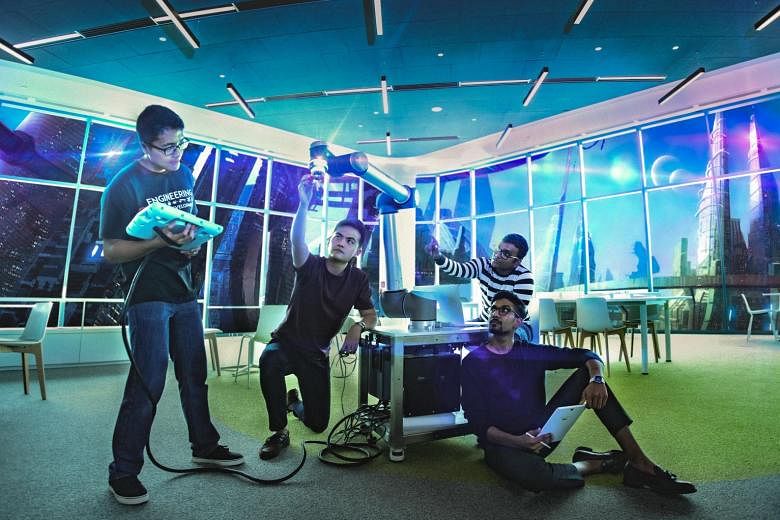A solar-powered pavilion that lets park-goers enjoy the outdoors despite a warming planet. A monitoring system for fall detection. An AI-powered automatic pill dispenser for the elderly. A smart robotic arm for the wheelchair-bound. And even a four-dimensional digital simulation platform to help urban planners build a sustainable Singapore. The list goes on and on.
These are some innovative, real-world solutions that students at the Singapore University of Technology and Design (SUTD) have designed in collaboration with government and industry partners such as NParks and GovTech.
More importantly, these solutions are born out of a desire to do something about the pressing, complex challenges the world faces today.
The 21st century is a volatile, uncertain, complex, ambiguous (VUCA) world where the industry has to deal with global challenges like Industry 4.0, cybersecurity, global sustainability, rapid urbanisation, ageing societies and more, says SUTD President Professor Chong Tow Chong.
Bold and innovative solutions for a VUCA world
To overcome multifaceted challenges that cut across different domains and sectors, the world needs interdisciplinary, bold and innovative solutions that are powered by new frontier technologies.
This is why our next generation needs to acquire not only hard skills such as artificial intelligence (AI), data science, product design and systems engineering, but also soft skills like design innovation, critical thinking, communication, creativity, entrepreneurship, a human-centric mindset and teamwork.
As countries worldwide rebuild post-Covid, a new generation of design innovators will help create a better world. But how do we promote a culture of creativity and innovation to generate radically new and workable ideas?
One of the world's most successful tech companies, Google credits its culture of innovation to design thinking, which it defines as "a practice that combines creativity and structure to solve complex problems". Its parent company Alphabet, for example, used design thinking to come up with an innovative way to utilise giant balloons to bring Internet access to Kenya's most inaccessible regions. A number of SUTD graduates, known for their deep knowledge of data science and AI, and skills in problem-solving as well as human-centric design thinking, are working in the US headquarters of Google and Facebook Inc.
Closer to home, SUTD graduates are contributing to nation-building through their work at GovTech (Government Technology Agency), URA (Urban Redevelopment Authority) and on the Changi Airport's Terminal 5 infrastructure project.
Pioneer in design-centric, interdisciplinary education
At the national level, good design thinking was a key reason for Singapore's successful journey from third world to first, says Singapore's Prime Minister Lee Hsien Loong.
"With design thinking, we turned adversities into opportunities, and even strengths. Now, as a first world country, design thinking will be critical for us to transform Singapore again, and to stay an outstanding city in the world," PM Lee said at a SUTD's Ministerial Forum in 2018.
"The whole institution of SUTD is focussed on identifying and analysing real-world problems, and coming up with comprehensive, systematic and analytical solutions, practical solutions," he added.
At SUTD, a pioneer in design-centric, interdisciplinary education, design thinking has been imbued into its pedagogy, curriculum and learning environment since day one.
Integral to the design thinking philosophy is the coming together of diverse voices and viewpoints. At SUTD, students collaborate with one another from across disciplines to brainstorm ideas, build prototypes and test them to create innovative and sustainable solutions.
Working in such diverse teams means they get to see things from different perspectives and pick up soft skills in critical thinking and teamwork. Most SUTD students typically complete 25 to 30 design projects in the course of their eight-term study.
"We make sure that design permeates almost everything we do in the university. That way, we address a lot of human needs," Prof Chong explains.
The first three terms are common to all students and build the foundation not only in Science, Mathematics and Technology, but also in Humanities, Arts and Social Sciences (HASS) and design. Around 20 per cent of the curriculum is devoted to HASS modules to help them develop critical thinking and an awareness of the social role, limitations and the impact of technology, as well as design innovation.
Human-centric approach to problem-solving
What differentiates design thinking from traditional ways of problem-solving is its human-centred approach and a deep understanding of the relationship we have with our society, culture and the environments.
At SUTD, students learn to put themselves in the shoes of the user to understand their needs. Combined with design thinking, such an empathetic approach makes for practicable innovation and solutions that meet the needs of people.
Take healthcare start-up KroniKare, for example. SUTD's faculty members and researchers collaborated to develop an AI-powered wound scanning technology that can assess chronic or diabetic wounds with a smartphone to generate and submit a detailed report to healthcare professionals in 30 seconds. This would allow for early detection and quicker intervention to save limbs and lives.
The idea was commercialised and shortlisted as a top 30 finalist of the Super AI Leader Award, the highest honour at the World Artificial Intelligence Conference 2019 attended by AI industry leaders Elon Musk and Jack Ma.
Seeing the fruits of innovation
From launching their own start-ups to pairing the students with an industry partner, students are supported throughout the innovation journey to bring a product from conceptualisation to implementation in the market. They also interact with venture capitalists and attend entrepreneurship workshops to pick up skills and build their professional networks.
As a research-intensive university, SUTD has 13 research centres. Among them are the Lee Kuan Yew Centre for Innovative Cities, ST Engineering-SUTD Centre for Smart Systems and SUTD-MIT International Design Centre, where students can participate in research from day one.
SUTD has also developed programmes in AI, healthcare, cities and aviation to tighten the integration between research, education and industry.
The students' eight-term education at SUTD culminates in an industry-based Capstone Design project that brings together senior-year students from five degree programmes offered by SUTD to work in multi-disciplinary design teams commissioned by companies.
Many of the innovative ideas developed under the Capstone programme have been endorsed and commercialised by the mentor companies.
SUTD graduates in demand in job market
Many employers recognise the imprint SUTD leaves on its students, who are highly sought after in the job market.
"SUTD graduates are different; their confidence is something I don't see in other graduates. They are very bold, they are also creative. They will always find solutions and are very open to learning," says Mr Yeo Siew Haip, managing director of SAA Architects.
Mr David Varvel, engineering director of software consulting company Pivotal Labs, too, has a very good impression of SUTD graduates: that they are universally bright, capable and ready to do complex engineering work.
"At Pivotal Labs, we expect our engineers to be able to code well and teach the best practices to the largest and most important organisations in Singapore. We have hired several ISTD graduates, and they all came with the theoretical and practical skills to immediately start having a high impact. An SUTD ISTD (Information Systems Technology and Design) degree is one of the first things we look for when we are hiring," he adds.
Click here to find out how SUTD nurtures the next generation of design innovators.


